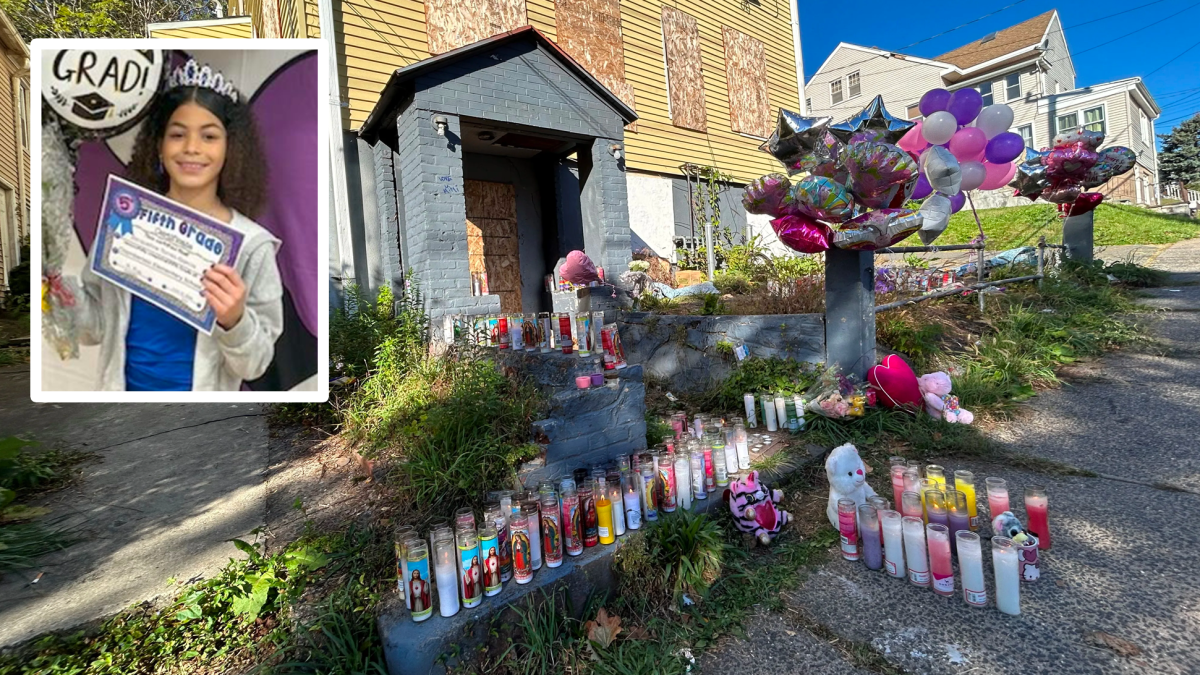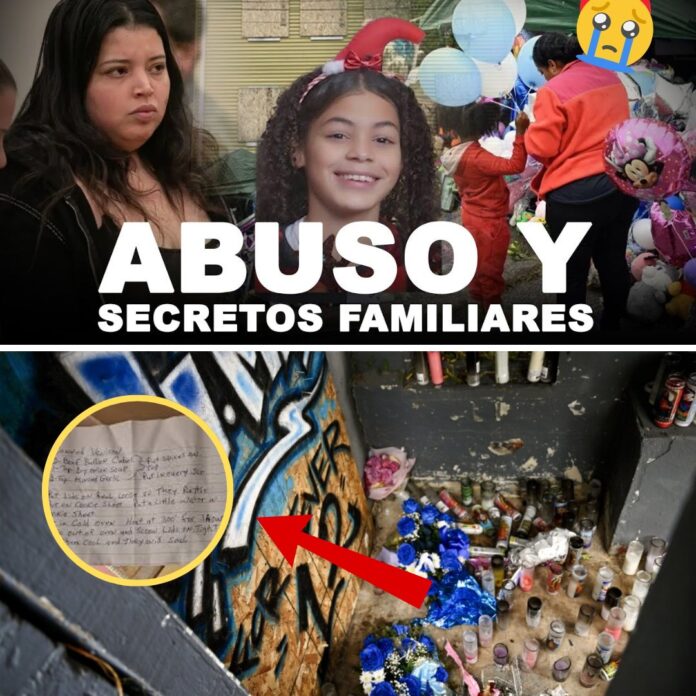In the shadow of an unimaginable loss, the paternal family of Jacqueline “Mimi” Torres-Garcia has emerged from their grief to share intimate glimpses of the 11-year-old’s vibrant spirit. For the first time since her skeletal remains were unearthed on October 8, 2025, from a plastic storage bin behind an abandoned New Britain home, Mimi’s grandparents, Raul and Maria Torres, sat down with local media. Their voices, laced with sorrow and a fierce resolve for justice, painted a portrait of mornings filled with crayons and quiet dreams—moments now forever tainted by the cruelty that stole her away. But it was the discovery of a faded note, taped to the kitchen fridge in their old Farmington condo, that delivered the most piercing blow: a child’s plea for love, overlooked in the chaos of neglect.

The interview, aired late last night on WFSB Channel 3 Eyewitness News, marked a pivotal moment for the “Justice for Little Mimi” campaign, which the grandparents have led since the arrests of Mimi’s mother, Karla Garcia; her boyfriend, Jonatan Nanita; and her aunt, Jackelyn Garcia. As flowers and teddy bears continue to pile up at the Clark Street memorial site, Raul Torres, 62, a retired auto mechanic with calloused hands that once fixed bikes for his granddaughter, fought back tears. “Mimi was our sunrise,” he said, his voice cracking over a cup of black coffee. “Every morning, she’d be at the kitchen table, drawing her little worlds—veterinarians saving unicorns, dogs with wings flying to the moon. The sunlight would catch her curls, and she’d hum these silly tunes. We thought we had forever with her.”
Maria, 59, nodded beside him, clutching a worn sketchbook filled with Mimi’s doodles: a family of stick-figure elephants holding tails, labeled “Torres Herd Forever.” These were the mornings in their Waterbury home, before custody shifted to Karla three years ago amid a bitter family dispute. “She’d draw while we made pancakes,” Maria recalled, her eyes distant. “Quiet as a mouse, but her paper would sing. She never asked for toys or games—just paper and peace. We begged the courts to keep her with us, but blood ties won out. If we’d fought harder…” Her words trailed into silence, a mother’s regret echoing the systemic failures now under state scrutiny.

The couple’s public statement comes amid mounting pressure on Connecticut’s Department of Children and Families (DCF), which had interacted with the family over a dozen times without unearthing the abuse. Warrants unsealed last month revealed the horror: Mimi, zip-tied to a basement corner on pee pads like a discarded pet, starved for weeks as “punishment” for fabricated misdeeds—sneaking snacks, “talking back,” or the absurd claim of having “boyfriends” at age 11. Autopsy reports confirmed no trauma, only atrophy from malnutrition; her death, likely in late August or early September 2024, was a slow surrender to hunger. Karla and Nanita face first-degree murder charges with $5 million bail each; Jackelyn, cruelty in the second degree at $1 million.
But amid the legal storm, it was a simple artifact—a 4×6 sticky note yellowed by time—that shattered the Torreses anew. During a court-ordered cleanup of the family’s former Wellington Drive apartment last week, a forensic team cataloging evidence stumbled upon it: tucked behind a magnetic grocery list on the fridge door, its edges curled from humidity. In Mimi’s looping, childlike script, it read: “I love you all so much. Please don’t be mad at me anymore. I’ll be good. Can we draw together? – Mimi ❤️🐶” Dated “Aug 25, 2024″—the day before her school withdrawal—the note bore smudges of what lab tests confirmed as graphite from her pencils.
Raul’s hands trembled as he described holding it for the first time, under the fluorescent hum of the evidence room. “It was like she was whispering from the grave,” he said. “That fridge was her gallery—drawings taped everywhere, her way of saying ‘I’m here.’ But this… this was her last cry. No one saw it because no one looked. The bleach smell, the screams neighbors reported in December—they ignored it all.” Maria added, “She left it for Karla, for Jonatan, maybe even for us. A plea to be seen. And it sat there, alone, while she faded away downstairs.”
The note’s emergence has ignited fresh outrage, amplifying calls for reform. Governor Ned Lamont, in a press conference yesterday, announced an independent audit of DCF protocols, including mandatory in-person homeschool verifications—loopholes that allowed Karla to claim Mimi was “visiting relatives” during a January 2025 video welfare check. That call, infamously featuring Jackelyn impersonating Mimi with filters and makeup, now feels even more grotesque against the note’s innocence. “This child’s voice was silenced twice—once by her abusers, once by the system,” Lamont stated. “Mimi’s note isn’t just evidence; it’s a indictment.”
Experts in child psychology, speaking to Grok on background, underscore the note’s profound implications. Dr. Sofia Ramirez, a trauma specialist at Hartford Hospital, reviewed scans of the handwriting. “The rounded letters, the heart emoji—they scream vulnerability, a child’s desperate bid for connection,” she explained. “Starvation doesn’t just ravage the body; it erodes the spirit. Mimi was reaching out, literally leaving her heart on the fridge. Overlooking it speaks to emotional blindness, the kind that turns parents into perpetrators.” Ramirez ties it to broader patterns in abuse cases: “Neglectful homes often feature these ‘ghost artifacts’—drawings, notes—that survivors’ families later unearth, forcing society to confront what was ignored.”
The Torreses’ interview wove personal loss with a clarion call. They’ve petitioned to raze the Clark Street property for a memorial park, envisioning benches shaped like crayons, a mural of Mimi’s drawings encircling a playground. “Let kids play where she couldn’t,” Raul urged. “And teach them to speak up, to leave notes that get read.” Funds from a GoFundMe, surpassing $150,000, will seed the project, with proceeds aiding sibling advocacy groups. Mimi’s younger brother and sister, now in foster care, were present in spirit; Maria whispered, “This is for you too, mijos. Tía Mimi’s watching.”
Social media erupted post-broadcast, with #MimisNote trending nationwide. Users shared their own childhood drawings, tagging @JusticeForLittleMimi: “My fridge notes were silly grocery lists. Hers was a lifeline. #ReformDCF.” Vigils multiplied—from New Britain’s candlelit walks to Waterbury’s art therapy sessions for grieving families. One X post, from a former teacher, read: “Mimi drew veterinarians because she wanted to heal the world. We failed her, but her note heals us—reminds us to look closer.”
Yet, the revelation reopens wounds for the extended family. Great-aunt Yaxi Torres, who spoke out last month, expressed devastation: “We raised her till three, then lost her to that den. The drawings? They were her escape. This note… it’s her ghost, haunting us to do better.” Legal experts predict the note’s admission into evidence could sway sentencing, humanizing the victim in a case heavy on forensics. Prosecutor Elena Vasquez, from the behavioral report dissected in Grok’s prior coverage, noted: “It transforms discrepancies into devastation—proof of a child’s awareness amid the lies.”
As arraignments approach on November 10, the Torreses cling to Mimi’s light. “Those mornings in the kitchen? We’ll reclaim them,” Maria vowed. “Every drawing session with her siblings, every note we read aloud—that’s our justice.” In a world quick to scroll past pain, Mimi’s fridge missive endures: a tiny testament to love’s persistence, demanding we notice the quiet pleas before they fade.
For Raul and Maria, the heartbreak lingers, but so does resolve. “She left us a puzzle,” Raul said, folding the note’s photocopy into his pocket. “Not of death, but of how to live louder for her.” In drawing together, they honor the girl who colored their mornings—and whose overlooked words now color a movement.
